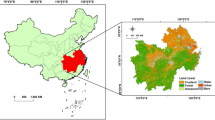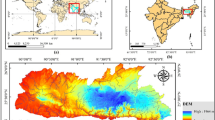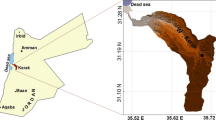Abstract
The identification and prioritization of high erosion-prone areas represent an important challenge at national and local levels to help the policymakers to propose correct interventions in land management issues. The main objective of this work was to analyze the spatial pattern of potential erosion in the upper Nazas River basin, for the identification of critical areas of soil loss. For that, Universal Soil Loss Equation (USLE) and the combination of both global (Moran’s I index) and local (Getis-Ord Gi*) spatial autocorrelation techniques were used. The results showed that most of the surface in the basin has low levels of erosion. However, there is a significant amount of surface with high, very high, and extreme erosion levels. The Moran’s I index revealed a significant positive spatial autocorrelation with a value of 0.3948, thus indicating a spatial pattern of potentially erosive clusters. The clustering types found through the local spatial autocorrelation test were hotspots and coldspots with statistically significant values (p ≤ 0.05), which allows us to identify those areas that are more vulnerable to more soil erosion. This provides policymakers and soil researchers with information on soil erosion processes at the local level, based on a reliable assessment of vulnerability and risk levels.






Similar content being viewed by others
References
Aguirre-Salado C, Miranda-Aragón L, Pompa-García M, Reyes-Hernández H, Soubervielle-Montalvo C, Flores-Cano J, Méndez-Cortés H (2017) Improving identification of areas for ecological restoration for conservation by integrating USLE and MCDA in a GIS-Environment: a pilot study in a priority region Northern Mexico. ISPRS Int J Geoinf. https://doi.org/10.3390/ijgi6090262
Alewell C, Egli M, Meusburger K (2015) An attempt to estimate tolerable soil erosion rates by matching soil formation with denudation in Alpine grasslands. J Soils Sediments 15(6):1383-e1399
Alewell C, Borrelli P, Meusburger K, Panagos P (2019) Using the USLE: Chances, challenges and limitations of soil erosion modelling. Int Soil Water Conserv Res 7:203–225. https://doi.org/10.1016/j.iswcr.2019.05.004
Amore E, Modica C, Nearing MA, Santoro VC (2004) Scale effect in USLE and WEEP application for soil erosion computation from three Sicilian basins. J Hydrol 293(1–4):100–114
Anselin L (1996) The Moran Scatterplot as an ESDA Tool to assess local instability in spatial association. In: Fischer M, Scholten H, Unwin D (eds) Spatial analytical perspectives on gis in environmental and socio-economic sciences, 1st edn. Taylor and Francis, pp 111–226
Anselin L (2003) GeoDa 0.9 user’s guide. Spatial Analysis Laboratory, University of Illinois, Urbana-Champaign
Aslam B, Naseer F (2020) A statistical analysis of the spatial existence of earthquakes in Balochistan: clusters of seismicity. Environ Earth Sci 79:41. https://doi.org/10.1007/s12665-019-8790-2
Asmamaw LB, Mohammed AA (2019) Identification of soil erosion hotspot areas for sustainable land management in the Gerado catchment, North-eastern Ethiopia. RSASE 13:306–317. https://doi.org/10.1016/j.rsase.2018.11.010
Avanzi JC, Silva MLN, Curi N, Norton LD, Beskow S, Martins SG (2013) Spatial distribution of water erosion risk in a watershed with eucalyptus and Atlantic Forest. Cienc Agrotecnol 37(5):427–434
Ávila-Flores DY, Pompa-García M, Vargas-Pérez E (2010) Spatial analysis of forest fire occurrence in the state of Durango. Rev Chapingo Ser Cienc Del Am 16(2):253–260
Bosco C, de Rigo D, Dewitte O (2014) Visual validation of the e-RUSLE model applied at the pan-European scale. Sci Top Focus. https://doi.org/10.6084/m9.figshare.844627
Cartus O, Kellndorfer J, Walker W, Franco C, Bishop J, Santos L, Fuentes JMM (2014) A national, detailed map of forest aboveground carbon stocks in Mexico. Remote Sens 6:5559–5588
Cerutti M, Rivas-Sada E (2008) La construcción de la cuenca lechera en La Laguna (1948–1975). Rev De Estud Soc 16(31):165–204
Chainey S, Reid S, Stuart N (2003) When is a hotspot a hotspot? A procedure for creating statistically robust hotspot maps of crime. In: Kidner D, Higgs G, White S (eds) Socio-economic applications of geographic information science. Taylor and Francis
Chuenchum P, Xu M, Tang W (2020) Estimation of soil erosion and sediment yield in the Lancang-Mekong river using the modified revised universal soil loss equation and GIS techniques. Water. https://doi.org/10.3390/w12010135
Comisión Nacional Forestal (CONAFOR) (2011) Recuperación de áreas degradadas por disturbios y/o perturbaciones antropogénicas. Términos de referencia Programa de Desarrollo Sustentable para las Comunidades Rurales e Indígenas del Noroeste Semiárido. http://www.conafor.gob.mx:8080/documentos/docs/1/2769Seminarios%20de%20Comunidad%20a%20Comunidad.pdf. (Accessed 19 Apr 2020)
Cotler H, López CA, Martínez-Trinidad S (2011) ¿Cuánto nos cuesta la erosión de suelos? Aproximación a una valoración económica de la pérdida de suelos agrícolas en México. Investigación Ambiental 3(2):31–43
Cowie AL, Orr BJ, Sanchez VMC et al (2018) Land in balance: the scientific conceptual framework for land degradation neutrality. Environ Sci Policy 79:25–35. https://doi.org/10.1016/j.catena.2016.07.003
Dai X, Guo Z, Zhang L, Li D (2010) Spatio-temporal exploratory analysis of urban surface temperature field in Shanghai. China Stoch Environ Res Risk Assess 24:247–257. https://doi.org/10.1007/s00477-009-0314-2
Desmet PJJ, Govers G (1996) A GIS-procedure for the automated calculation of the USLE-LS factor on topographically complex land units. J Soil Water Conserv 51:427–433
Dissanayake DMSLB, Morimoto T, Ranagalage M (2019) Accessing the soil erosion rate based on RUSLE model for sustainable land use management: a case study of the Kotmale watershed, Sri Lanka. Model Earth Syst Environ 5:291–306. https://doi.org/10.1007/s40808-018-0534-x
Durigon V, Carvalho D, Antunes M, Oliveira P, Fernández M (2014) NDVI time series for monitoring RUSLE cover management factor in a tropical watershed. Int J Remote Sens. https://doi.org/10.1080/01431161.2013.871081
Falcão CJLM, Araújo-Duarte SM, da Silva-Veloso A (2020) Estimating potential soil sheet Erosion in a Brazilian semiarid county using USLE, GIS, and remote sensing data. Environ Monit Assess. https://doi.org/10.1007/s10661-019-7955-5
Farr T, Rosen PA, Caro E et al (2007) The shuttle radar topography mission. Rev Geophys 45(2):1–33
Feng Y, Chen L, Chen X (2019) The impact of spatial scale on local Moran’s I clustering of annual fishing effort for Dosidicus gigas offshore Peru. J Oceanol Limnol 37:330–343
Foster GR, McCool DK, Renard KG, Moldenhauer WC (1981) Conversion of the universal soil loss equation to SI metric units. J Soil Water Conserv 36:355–359
Galloza MS, López-Santos A, Martínez-Santiago S (2017) Predicting land at risk from wind erosion using an index-based framework under a climate change scenario in Durango. Mexico Environ Earth Sci 76:1–14. https://doi.org/10.1007/s12665-017-6751-1
Ganasri BP, Ramesh H (2016) Assessment of soil erosion by RUSLE model using remote sensing and GIS-A case study of Nethravathi Basin. Geosci Front 7:953–961. https://doi.org/10.1016/j.gsf.2015.10.007
García E (2004) Modificaciones al sistema de clasificación climática de Köppen. Instituto de Geografía de la Universidad Nacional Autónoma de México
Getis A, Ord JK (1992) The analysis of spatial association by use of distance statistics. Geogr Anal 24:189–206. https://doi.org/10.1007/978-3-642-01976-0_10
Gónzales-Barrios JL, Descroix L, Jasso-Ibarra R, Estrada J, Bollery A, Solis-Moreno R, Sánchez-Cohen I (2007) Impacto de los sistemas productivos en la cuenca alta del Rio Nazas: análisis del problema de degradación física de una cuenca productora de agua. Avances de Investigación en agricultura sostenible. Bases metodológicas para el manejo integral de cuencas hidrológicas. https://hal.archives-ouvertes.fr/hal-02174023/. (Accessed 09 Sept 2020)
Huang J (2018) Assessment of potential changes in soil erosion using remote sensing and GIS: a case study of Dacaozi Watershed. China Environ Monit Assess. https://doi.org/10.1007/s10661-018-7120-6
FAO and ITPS (2015) Status of the world’s soil resources (SWSR) – main report. food and agriculture organization of the United Nations and intergovernmental technical panel on soils, Rome, Italy. http://www.fao.org/documents/card/es/c/c6814873-efc3-41db-b7d3-2081a10ede50/. (Accessed 19 Apr 2020).
IUSS Working Group WRB (2015) World reference base for soil resources 2014, update 2015. International soil classification system for naming soils and creating legends for soil maps. FAO, Rome
Johnson LC (1987) Soil loss tolerance: fact or myth? J Soil Water Conserv 42:155–160
Kapalanga TS (2008) A review of land degradation assessment methods. Land Restoration Training Programme
Karan SK, Ghosh S, Samadder SR (2019) Identification of spatially distributed hotspots for soil loss and erosion potential in mining areas of Upper Damodar Basin – India. CATENA 182:104144. https://doi.org/10.1016/j.catena.2019.104144
Khanchoul K, Boubehziz S (2019) Spatial variability of soil erodibility at El Hammam catchment, northeast of Algeria. Environ Ecosyst Sci (EES) 3:17–25. https://doi.org/10.26480/ees.01.2019.17.25
Kim SM, Choi Y (2017) Assessing statistically significant heavy-metal concentrations in abandoned mine areas via hot spot analysis of portable XRF data. Int J Environ Res Pub Health 14:654
Kumar S, Mishra A (2015) Critical erosion area identification based on hydrological response unit level for effective sedimentation control in a river basin. Water Resour Manag 29:1749–1765. https://doi.org/10.1007/s11269-014-0909-3
Lal R (1994) Soil erosion research methods. CRC Press, Boca Ratón
Lal R (2017) Soil erosion by wind and water: problems and prospects. In: Lal R (ed) Soil erosion research methods, 2nd edn. Soil and Water Conservation Society, Routledge, pp 1–10
Lal R, Sobecki TM, Iivari T (2004) Soil degradation in the United States: extent, severity, and trends. Lewis Publishers, Boca Raton
Lanorte A, Danese M, Lasaponara R, Murgante B (2013) Multiscale mapping of burn area and severity using multisensor satellite data and spatial autocorrelation analysis. Int J Appl Earth Obs Geoinf 20:42–51. https://doi.org/10.1016/j.jag.2011.09.005
Li L, Du S, Wu L, Liu L (2009) An overview of soil loss tolerance. CATENA 78:93–99. https://doi.org/10.1016/j.catena.2009.03.007
Li Y, Zhang L, Yan J, Wang P, Hu N, Cheng W, Fu B (2017) Mapping the hotspots and coldspots of ecosystem services in conservation priority setting. J Geogr Sci 27:681–696. https://doi.org/10.1007/s11442-017-1400-x
Li J, Heap AD (2008) A review of spatial interpolation methods for environmental scientists. Geoscience Australia, Record 2008/23
Liu X, Zhang Y, Li P (2020) Spatial variation characteristics of soil erodibility in the Yingwugou watershed of the middle dan river, China. Int J Environ Res Public Health. https://doi.org/10.3390/ijerph17103568
López-García EM, Torres-Trejo E, López-Reyes L, Flores-Domínguez AD, Peña-Moreno RD, López-Olguín JF (2019) Estimation of soil erosion using USLE and GIS in the locality of Tzicatlacoyan, Puebla, México. Soil Water Res 15(1):9–17. https://doi.org/10.17221/165/2018-SWR
López-Santos A (2016) Neutralizar la degradación de la tierra, una aspiración global. ¿Es posible lograrlo en México? Terra Latinoam 34:239–249
Marzen M, Iserloh T, de Lima J, Fister W, Ries JB (2017) Impact of severe rain storms on soil erosion: experimental evaluation of wind driven rain and its implications for natural hazard management. Sci Total Environ 590:502–513
McCool DK, Brown LC, Foster GR, Mutchler CK, Meyer LD (1987) Revised slope steepness factor for the Universal Soil Loss Equation. Trans ASAE 30:1387–1396. https://doi.org/10.13031/2013.30576
Secretaría de Medio Ambiente y Recursos Naturales (SEMARNAT) (2003) Evaluación de la degradación del suelo causada por el hombre en la República Mexicana (escala 1:250.000). Colegio de Postgraduados (CP). Memoria Nacional. https://www.researchgate.net/publication/307967321_SEMARNAT-CP_2003_Memoria_Nacional_2001-2002_Evaluacion_de_la_Degradacion_del_Suelo_causada_por_el_Hombre_en_la_Republica_Mexicana_escala_1250000_Memoria_Nacional. (Accessed 20 Apr 2020)
Mekonnen M, Melesse AM (2011) Soil erosion mapping and hotspot area identification using GIS and remote sensing in northwest Ethiopian highlands near Lake Tana. In: Melesse AM (ed) Nile River Basin, 1st edn. Springer, Dordrecht, pp 207–224
Meliho M, Khattabi A, Mhammdi N (2020) Spatial assessment of soil erosion risk by integrating remote sensing and GIS techniques: a case of Tensift watershed in Morocco. Environ Earth Sci 79:207. https://doi.org/10.1007/s12665-020-08955-y
Meshesha DT, Tsunekawa A, Tsubo M, Haregeweyn N (2012) Dynamics and hotspots of soil erosion and management scenarios of the Central Rift Valley of Ethiopia. Int J Sediment Res 27:84–99. https://doi.org/10.1016/S1001-6279(12)60018-3
Mihi A, Benarfa N, Arar A (2020) Assessing and mapping water erosion-prone areas in northeastern Algeria using analytic hierarchy process USLE/RUSLE equation, GIS, and remote sensing. Appl Geomat 12:179–191
Montanarella L, Pennock DJ, McKenzie N et al (2016) World’s soils are under threat. Soil 2:79–82. https://doi.org/10.5194/soil-2-79-2016
Montes-León MAL, Uribe-Alcántara EM, García-Celis E (2011) Mapa Nacional de erosión potencial. Tecnol Ciencias Del Agua 2:5–17
Moran PA (1950) Notes on continuous stochastic phenomena. Biometrika 37:17–23
Instituto Nacional de Geografía y Estadística (INEGI) (2013) Continuo Mexicano de elevaciones. https://www.inegi.org.mx/app/geo2/elevacionesmex/. (Accessed 19 Apr 2020)
Instituto Nacional de Geografía y Estadística (INEGI) (2014) Conjunto de datos vectoriales edafológico, Serie II. (Continuo Nacional), escala: 1:250000. 2 edn. https://www.inegi.org.mx/app/biblioteca/ficha.html?upc=702825235680. (Accessed 20 Apr 2020)
Nehaï SA, Guettouche MS (2020) Soil loss estimation using the revised universal soil loss equation and a GIS-based model: a case study of Jijel Wilaya Algeria. Arab J Geosci. https://doi.org/10.1007/s12517-020-5160-z
Ortiz SCA, Cuanalo HE (1984) Metodología del levantamiento fisiográfico: un sistema de clasificación de tierras. Colegio de Postgraduados, Chapingo
Panagos P, Borrelli P, Meusburger K et al (2017) Global rainfall erosivity assessment based on high-temporal resolution rainfall records. Sci Rep. https://doi.org/10.1038/s41598-017-04282-8
Parveen R, Kumar U (2012) Integrated approach of universal soil loss equation (USLE) and geographical information system (GIS) for soil loss risk assessment in Upper South Koel Basin Jharkhand. J Geogr Inf Syst. https://doi.org/10.4236/jgis.2012.46061
Pérez-Salinas JE, Rodríguez FR, López-Santos A, Torres González JA, Meraz-Jiménez AJ, Díaz-Romo A, Valdivia OM (2019) Erodabilidad y riesgo de erosión de suelos negros del centro de México: estudio de un Phaozem. Terra Latinoam 37:391–400. https://doi.org/10.28940/terra.v37i4.531
Pham TG, Degener J, Kappas M (2018) Integrated universal soil loss equation (USLE) and Geographical Information System (GIS) for soil erosion estimation in A Sap basin: Central Vietnam. Int Soil Water Conserv Res 6:99–110. https://doi.org/10.1016/j.iswcr.2018.01.001
Pompa-García M, Antonio-Nemiga X, Carrasco-Mejorado JA, Mendoza-Briseño MA (2011) Spatial patterns of soil degradation in Mexico. Afr J Agric Res 6:1109–1113
Rahman MR, Shi ZH, Chongfa C, Dun Z (2015) Assessing soil erosion hazard-a raster based GIS approach with spatial principal component analysis (SPCA). Earth Sci Inform 8:853–865. https://doi.org/10.1007/s12145-015-0219-1
Rodríguez FJ, Pompa-García M, Hernández-Díaz C, Juárez-Reyes A (2010) Patrón de distribución espacial de la pérdida, degradación y recuperación vegetal en Durango, México. Av En Invest Agropecuaria 14:53–66
Salas-Aguilar VM, Pinedo-Álvarez C, Viramontes-Olivas OA, Báez-González AD, Quintana-Martínez RM (2011) Morfometría de la cuenca del río Nazas-Rodeo aplicando tecnología geoespacial en Durango, México. Tecn Chihuahua 5:34–42
Sanchez-Cuervo AM, Aide TM (2013) Identifying hotspots of deforestation and reforestation in Colombia (2001–2010): implications for protected areas. Ecosphere 4(11):1–21
Sexton JO, Song XP, Feng M et al (2013) Global, 30-m resolution continuous fields of tree cover: landsat-based rescaling of MODIS vegetation continuous fields with lidar-based estimates of error. Int J Digit Earth 6:427–448
Shit PK, Nandi AS, Bhunia GS (2015) Soil erosion risk mapping using RUSLE model on Jhargram sub-division at West Bengal in India. MESE. https://doi.org/10.1007/s40808-015-0032-3
Singh G, Panda RK (2017) Grid-cell based assessment of soil erosion potential for identification of critical erosion prone areas using USLE, GIS and remote sensing: a case study in the Kapgari watershed. India Int Soil Water Conserv Res 5:202–211
Smetanová A, Müller A, Zargar M, Suleiman MA, Gholami FR, Mousavi M (2020) Mesoscale mapping of sediment source hotspots for dam sediment management in data sparse semi-arid catchments. Water. https://doi.org/10.3390/w12020396
Solís-Moreno R, Treviño-Garza EJ, Aguirre OA, Jiménez-Pérez J, Jurado-Ybarra E (2006) Análisis de la cubierta vegetal de la cuenca alta del Río Nazas en Durango México. Rev Chapingo Ser Cienc for y Del Ambient 12(2):139–143
Tamene L, Adimassu Z, Ellison J, Yaekob T, Woldearegay K, Mekonnen K, Thorne P, Le QB (2017) Mapping soil erosion hotspots and assessing the potential impacts of land management practices in the highlands of Ethiopia. Geomorphology 292:153–163. https://doi.org/10.1016/j.geomorph.2017.04.038
UN-Habitat-GLTN (2016) Scoping and status study on land and conflict: towards UN system-wide engagement at scale. United Nations Human Settlements Programme Report 5/2016. http://www.gltn.net/index.php/publications/publications/download/2gltndocuments/2343scoping-and-status-study-on-landand-conflict. (Accessed 20 Apr 2020)
Van Remortel RD, Hamilton ME, Hickey RJ (2001) Estimating the LS factor for RUSLE through iterative slope length processing of digital elevation data within ArcInfo grid. Cartography 30:27–35
Villanueva-Díaz J, Luckman BH, Stahle DW et al (2005) Hydroclimatic variability of the upper Nazas basin: Water management implications for the irrigated área of the Comarca Lagunera, Mexico. Dendrochronologia 22:215–223
Viramontes D, Descroix L (2003) Changes in the surface water hydrologic characteristics of an endoreic basin of northern Mexico from 1970 to 1998. Hydrol Process 17:1291–1306
Wang B, Zheng F, Guan Y (2016) Improved USLE-K factor prediction: a case study on water erosion areas in China. Int Soil Water Conserv Res 4:168–176. https://doi.org/10.1016/j.iswcr.2016.08.003
Wang NZ, Yao W, Liu X, Ma M (2019) spatial variabilities of runoff erosion and different underlying surfaces in the Xihe River basin. Water. https://doi.org/10.3390/w11020352
Wang B, Zhao X, Wang X, Zhang Z, Yi L, Hu S (2020) Spatial and temporal variability of soil erosion in the black soil region of Northeast China from 2000 to 2015. Environ Monit Assess 192(37):1–14. https://doi.org/10.1007/s10661-020-08298-y
Wei W, Chen L, Fu B, Huang Z, Wu D, Gui L (2007) The effect of land uses and rainfall regimes on runoff and soil erosion in the semi-arid loess hilly area. China J Hydrol 335(3–4):247–258. https://doi.org/10.1016/j.jhydrol.2006.11.016
Wischmeier WH, Smith DD (1978) Predicting rainfall erosion losses—a guide to conservation planning. US Department of Agriculture, Washington
Zhang L, Bai KZ, Wang MJ, Karthikeyan R (2016) Basin-scale spatial soil erosion variability: pingshuo opencast mine site in Shanxi Province, Loess Plateau of China. Nat Hazards 80:1213–1230
Zhang W, Zhang Z, Liu F, Qiao Z, Hu S (2011) Estimation of the USLE cover and management factor C using satellite remote sensing: A review. In 2011 19th International Conference on Geoinformatics (pp. 1–5). IEEE
Zhu M (2012) Soil erosion risk assessment with CORINE model: case study in the Danjiangkou reservoir region, China. Stoch Environ Res Risk Assess 26:813–822. https://doi.org/10.1007/s00477-011-0511-7
Zúñiga-Vásquez JM, Pompa-García M (2019) The occurrence of forest fires in Mexico presents an altitudinal tendency: a geospatial analysis. Nat Hazards 96:213–224. https://doi.org/10.1007/s11069-018-3537-z
Zúñiga-Vásquez JM, Cisneros-González D, Pompa-García M, Rodríguez-Trejo DA, Pérez-Verdín G (2017) Spatial modeling of forest fires in Mexico: an integration of two data sources. Bosque 38:563–574. https://doi.org/10.4067/S0717-92002017000300014
Acknowledgements
We recognize the National Council of Science and Technology (CONACYT) for the support for the Doctorate studies of the first and third author. Jorge Alberto Garza Cossío helped by commenting on a previous version of this manuscript. Also, we are grateful to the editor and anonymous reviewers for their useful comments and suggestions.
Author information
Authors and Affiliations
Corresponding author
Additional information
Publisher's Note
Springer Nature remains neutral with regard to jurisdictional claims in published maps and institutional affiliations.
Rights and permissions
About this article
Cite this article
Cabral-Alemán, C., López-Santos, A. & Zúñiga-Vásquez, J.M. Mapping risk zones of potential erosion in the upper Nazas River basin, Mexico through spatial autocorrelation techniques. Environ Earth Sci 80, 653 (2021). https://doi.org/10.1007/s12665-021-09956-1
Received:
Accepted:
Published:
DOI: https://doi.org/10.1007/s12665-021-09956-1




